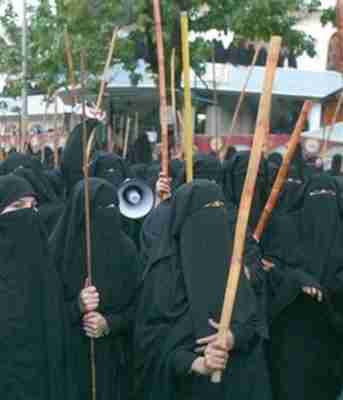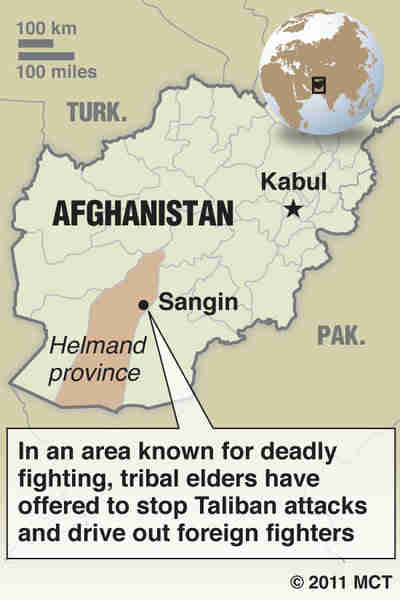Islamist lawyers showered Mumtaz Qadri with roses when he arrived in court on Wednesday to face charges of having assassinated Salman Taseer, the governor of the province of Punjab in Pakistan, according to Dawn (Pakistan). And MEMRI has translated a statement by 500 Pakistani religious scholars, mostly belonging to the terrorist organization Jamaat Ahle Sunnat Pakistan, praising Qadri for keeping alive a “tradition of 1,400 years in Islam” which requires the killing of anyone committing an act of blasphemy against Prophet Mohammed.
 Protesting female students at Red Mosque seminary wearing burkas and carrying bamboo sticks in 2007
Protesting female students at Red Mosque seminary wearing burkas and carrying bamboo sticks in 2007
The assassination is only the latest in an almost weekly stream of terrorist attacks by al-Qaeda linked groups in Pakistan. Many of them have been particularly targeted shrines and worshippers of Sufi and Shia Muslim sects, considered by Islamists to be apostasies.
Pakistan has been a troubled nation since its birth, where there have been militias particularly targeting Indians in Kashmir.
Pakistan really began turning against itself in 2007, with the bloody confrontation between police and students in Lal Masjid or the Red Mosque in Islamabad. (See my 2007 article, “Pakistanis are increasingly joining forces with al-Qaeda.”)
Trouble began when female students began wearing head-to-toe black burkas and, in a move heavy with sexual symbolism, began carrying bamboo sticks. They demanded that all the Islamabad prostitutes be arrested for violating Islamic law, but they weren’t taken seriously until they began abducting prostitutes and locking them in the seminary. This led to a 36-hour siege and gunfight with police — the male students were carrying guns, not bamboo sticks — that ended up killing more than 100 people.
A seminary student interviewed before the gunfight said that she was prepared to die for God. After the six hour gun battle she said, “We are never afraid. One day all lives will end, and if this is the case, then why not give our life to Islam?”
Since then, there have been numerous news stories about boys and girls, having been trained in Islamist madrassas, saying that they were ready to become martyrs to Allah. Sunni Islamist groups in Pakistan seem to have an endless supply of young people willing to become suicide bombers.
Now let’s contrast all this to what’s happening next door in Afghanistan.
 Helmand’s Sangin district in Afghanistan (McClatchy)
Helmand’s Sangin district in Afghanistan (McClatchy)
On Monday, an influential Afghan tribe leader agreed to put a stop to Taliban attacks in the Sangin district of Helmand, according to McClatchy. The deal is being compared to the “Anbar Awakening” in Iraq, where Sunni Iraqis turned against al-Qaeda in Iraq. This is raising hopes that there’ll be a similar “Awakening” in Afghanistan, bringing the war to an end.
There’s another major similarity to Iraq that, to my knowledge, has never reported except on my web site.
According to a July, 2007, study by the Jamestown Foundation entitled “The Taliban Fedayeen: The World’s Worst Suicide Bombers?”:
“An analysis of the attacks carried out in the last two years reveals a curious fact. In 43% of the bombings conducted last year and in 26 of the 57 bombings traced in this study up to June 15, the only death caused by the bombing was that of the bomber himself. Astoundingly, approximately 90 suicide bombers in this two year period succeeded in killing only themselves. This number exceeds 100 when you factor in those who succeeded in killing only one person in addition to themselves. There was one period in the spring of 2006 (February 20 to June 21) when a stunning 26 of the 36 suicide bombers in Afghanistan (72%) only killed themselves. … These statistics also represent a uniquely Afghan phenomenon that warrants investigation.”
What almost nobody has noticed is that a very similar phenomenon occurred in Iraq.
In April, 2007, I wrote “”Iraqi Sunnis are turning against al-Qaeda in Iraq.”” I was able to show by quoting documents from a variety of sources that the Iraqis themselves had little interest in fighting against each other, though al-Qaeda did everything possible to provoke them.
One of the most interesting examples was a letter of complaint from al-Qaeda in Iraq leader Abu Musab al-Zarqawi to Osama bin Laden, including the following:
“Jihad here unfortunately [takes the form of] mines planted, rockets launched, and mortars shelling from afar. The Iraqi brothers still prefer safety and returning to the arms of their wives, where nothing frightens them. Sometimes the groups have boasted among themselves that not one of them has been killed or captured. We have told them in our many sessions with them that safety and victory are incompatible, that the tree of triumph and empowerment cannot grow tall and lofty without blood and defiance of death, that the [Islamic] nation cannot live without the aroma of martyrdom and the perfume of fragrant blood spilled on behalf of God, and that people cannot awaken from their stupor unless talk of martyrdom and martyrs fills their days and nights.”
It was shown that Iraqis were refusing to allow their children to become suicide bombers, and so al-Zarqawi had to import suicide bombers from Saudi Arabia and Jordan.
The experiences of Afghanistan and Iraq are dramatically different from what’s happening in Pakistan, which is increasing turning against itself with its never-ending supply of young suicide bombers.
This dramatic difference has been possibly the most fascinating aspect of my development of Generational Dynamics over these last nine years. When a country has had a recent generational crisis war — as in the case of Iraq, Afghanistan, Iran, Lebanon and Thailand — then the population is strongly attracted away from violence. In particular, a civil war is impossible or, if one occurs, then it fizzles quickly.
But Pakistan’s last generational crisis war was the genocidal war between Hindus and Muslims that followed Partition, the 1947 partitioning of the Indian subcontinent into India and Pakistan.
In many current and historical examples that I’ve studied, the pattern is overwhelmingly consistent. Even when a generational crisis civil war ends, there is little or no internal violence for about 25-30 years. We’ve seen this quite dramatically in Sri Lanka, whose civil war ended last year. Pundits and analysts predicted that fighting would continue, but there has been no fighting whatsoever.
After about 25-30 years after a crisis civil war, low level violence can begin. This violence gradually increases, often punctuated by short-lived peace agreements, until a new war begins decades later.
So what does this mean for the war in Afghanistan? Can that war wind down the same as the war in Iraq seems to be doing?
As I’ve said many times, the answer is no, because of two very important differences between the two countries.
The first difference is that Afghanistan’s last crisis war was an extremely bloody civil war (1992-96), while Iraq’s last crisis war as an external war (the Iran/Iraq war, 1980-88). This means that Iraq’s Sunni and Shia population can comfortably form a shared government, at least for the time being.
With Afghanistan still in a generational Recovery era, there is almost no taste for war of any kind, even between people who, just 15 years ago, were literally slitting each others throats.
This is where the second difference becomes important. The Iraqi Sunnis were Iraqis first and Sunnis second, and had little identity with external Arab Sunni groups.
But the Sunni group in Afghanistan is the Pashtuns, and there is a strong identity group connection with the Pashtuns in Pakistan. The Taliban terrorist group is drawn from the Pashtun ethnic group. From the point of view of Generational Dynamics, this is a fascinating research subject, since the Afghan Pashtuns are in a generational Recovery era, while the Pakistan Pashtuns are in a generational Crisis era.
But the Afghan Pashtuns will not be able to eject the Pakistani Pashtuns in the way that the Iraqis ejected al-Qaeda in Iraq.
This means that Pakistan’s never-ending supply of suicide bombers becomes Afghanistan’s never-ending supply of suicide bombers.
My expectation is that there will be more deals with Afghan tribal leaders like the one that was announced on Monday, especially in the western regions far from the Pakistani border.
But I expect no such deals near the Pakistani border, or if there are any, they will be quickly sabotaged by the Pakistani Pashtuns. If only the border between Pakistan and Afghanistan could somehow be closed, then the Afghan war would end quickly. But that’s not possible.
The larger picture is that Afghanistan is to play a secondary role to the major war, the one between Pakistan and India. This will refight the 1947 war between Hindus and Muslims, with Pakistan itself torn between Sunni and Shia Muslims.
Pakistan has not yet recovered from last year’s devastating floods that covered 20% of the country. That lawyers, supposedly committed to upholding the law, would be throwing rose petals at the man who killed the governor of Punjab is almost too much to believe. And this comes as the government is close to collapse because a political party has pulled out of the governing coalition. Pakistan is truly staring into the abyss.
COMMENTS
Please let us know if you're having issues with commenting.